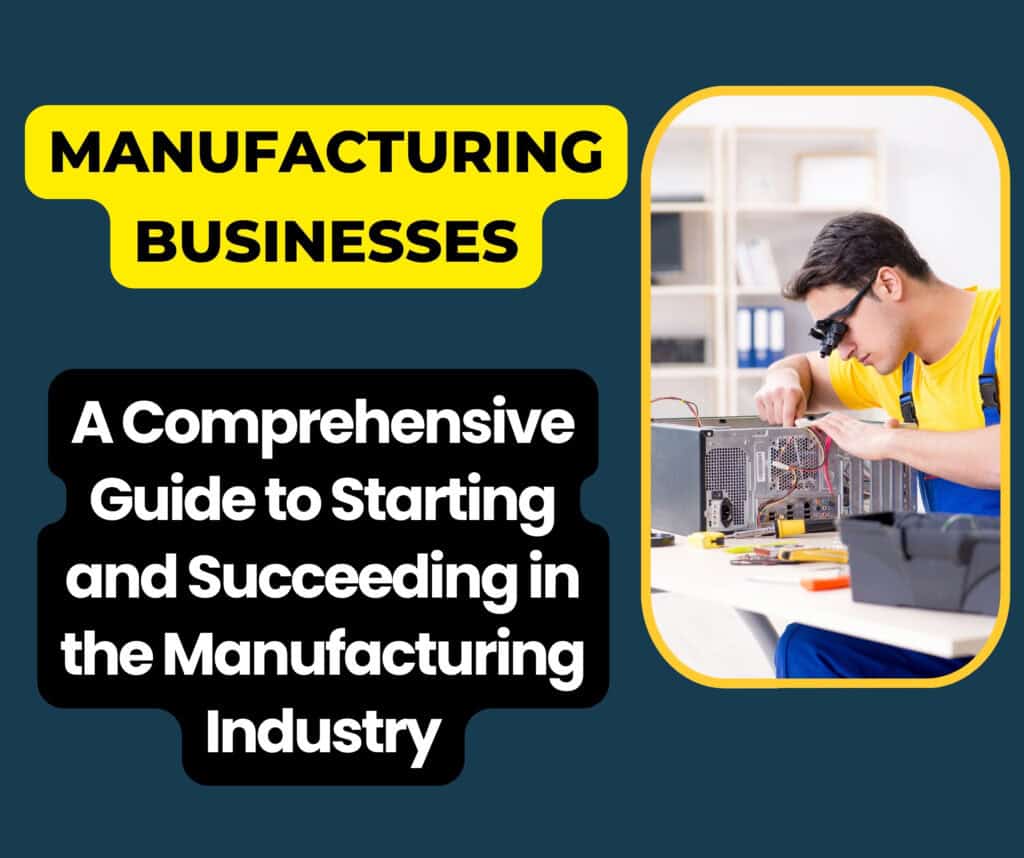The manufacturing business industry plays a crucial role in shaping the global economy. Encompassing a diverse range of sectors—from automotive and electronics to textiles and food production—manufacturing involves the transformation of raw materials into finished goods. This process not only contributes to the availability of products that consumers use daily but also serves as a backbone for innovation and technological advancement. As industries continue to evolve, manufacturing remains at the forefront, adapting to new technologies and consumer demands.
Significance of Manufacturing to the Economy:
Manufacturing is often referred to as the engine of economic growth, and for good reason. It significantly contributes to job creation, generating millions of employment opportunities worldwide. According to the National Association of Manufacturers (NAM), the manufacturing sector supports approximately 17.4 million jobs in the United States alone, encompassing both direct and indirect employment. Furthermore, the industry is a major driver of exports; manufactured goods account for a substantial portion of international trade, fostering global economic relationships and enhancing a country’s competitive advantage.
The manufacturing sector also stimulates economic development by fostering ancillary businesses, such as logistics, supply chain management, and service industries that cater to manufacturing needs. Additionally, it contributes to local economies through taxes and infrastructure development, enhancing community resources and opportunities.
Scope of Opportunities for Entrepreneurs in Manufacturing:
For aspiring entrepreneurs, the manufacturing industry presents a wealth of opportunities. With the rise of technology and innovation, new niches are emerging that allow businesses to operate efficiently and meet specific market demands. Entrepreneurs can tap into trends such as sustainable manufacturing, which focuses on eco-friendly processes and materials, or advanced manufacturing technologies, including automation and robotics.
Small-scale and custom manufacturing businesses are particularly appealing for startups, as they allow for flexibility, creativity, and personalized customer service. Many entrepreneurs are leveraging local resources and sustainable practices to create unique products that resonate with environmentally conscious consumers. Additionally, advancements in 3D printing and additive manufacturing open doors for entrepreneurs to develop prototypes rapidly and produce items on demand, reducing waste and increasing efficiency.
Moreover, the increasing globalization of markets presents opportunities for manufacturers to expand their reach beyond local borders. By exploring export markets or establishing partnerships with international firms, entrepreneurs can scale their businesses and diversify their revenue streams.
Your path to financial independence begins with a choice. Make it today!
Try Wealthy Affiliate (For Free).
What is a Manufacturing Business?
Manufacturing businesses are entities that produce goods through the transformation of raw materials into finished products. This process can involve a variety of techniques, including machining, assembling, and packaging, which are aimed at creating tangible items that can be sold to consumers or other businesses. The manufacturing sector is a vital component of the economy, as it not only fulfills consumer needs but also drives innovation and technological advancements across various industries.
Defining Manufacturing Businesses
At its core, a manufacturing business is defined by its primary activity: the creation of products. These businesses can range from small workshops producing handcrafted items to large factories employing thousands of workers to produce mass-market goods. Manufacturing can be categorized into several types, including:
- Discrete Manufacturing: Involves the production of distinct items, such as cars, electronics, and furniture. Each product is typically produced in separate units.
- Process Manufacturing: Focuses on the production of goods that are produced in bulk, often involving chemical processes. Examples include food and beverage production, pharmaceuticals, and petrochemicals.
- Batch Manufacturing: Involves producing goods in groups or batches, allowing for greater flexibility and customization. This method is often used in industries such as textiles and baked goods.
- Continuous Manufacturing: Involves the nonstop production of goods, typically for high-volume items, such as oil or electricity. This method is efficient but requires significant investment in technology and infrastructure.
The Role of Manufacturing in Product Development and Supply Chains
Manufacturing plays a crucial role in product development and the broader supply chain ecosystem. It serves as a bridge between raw material suppliers and consumers, facilitating the transformation of resources into market-ready products. Here’s how manufacturing fits into these processes:
- Product Development: Manufacturing is integral to product development, providing the capabilities to create prototypes, test designs, and refine processes. Manufacturers work closely with product designers and engineers to ensure that the final product meets quality standards, regulatory requirements, and market demands. This collaboration can lead to innovative solutions and improvements in product functionality and design.
- Supply Chain Integration: In a typical supply chain, manufacturing is one of several key components that also includes sourcing raw materials, distribution, and retail. Effective manufacturing operations ensure that products are produced efficiently, on time, and at the required quality level. This efficiency reduces lead times and inventory costs, allowing businesses to respond swiftly to market changes and consumer demands.
- Logistics and Distribution: Once products are manufactured, they must be packaged and distributed to retailers or directly to consumers. Manufacturing businesses often collaborate with logistics providers to streamline transportation and delivery, ensuring that products reach their destination promptly.
Different Types of Manufacturing Operations
The manufacturing landscape is diverse, and businesses may adopt different operational models based on their goals, target markets, and production capabilities. Key types of manufacturing operations include:
- Custom Manufacturing: This approach focuses on producing unique products tailored to specific customer requirements. Custom manufacturers often work on a project basis and may produce items like machinery, specialized tools, or custom furniture. This type of manufacturing allows for creativity and personalized service, catering to niche markets.
- Mass Production: Involves the large-scale production of standardized products, often using assembly lines or automated processes. Mass production is highly efficient and cost-effective, making it suitable for high-demand consumer goods such as automobiles, electronics, and household items. By producing in bulk, manufacturers can lower per-unit costs and achieve economies of scale.
- Lean Manufacturing: This methodology emphasizes reducing waste and improving efficiency throughout the manufacturing process. Lean principles focus on optimizing workflows, minimizing inventory, and enhancing product quality. Many manufacturers adopt lean practices to remain competitive and respond to changing market conditions.
- Agile Manufacturing: This model is designed to be flexible and responsive to changing customer needs and market dynamics. Agile manufacturers can quickly adapt their production processes, enabling them to deliver customized products without sacrificing efficiency. This approach is particularly beneficial in industries with rapidly evolving trends, such as fashion and technology.
Types of Manufacturing Businesses
The manufacturing industry is diverse, encompassing various business models that cater to different markets and consumer needs. Understanding the types of manufacturing businesses can help entrepreneurs choose the right path for their ventures. Below are the primary types of manufacturing operations:
Small-Scale Manufacturing
Benefits for Startups and Local Markets: Small-scale manufacturing refers to businesses that produce goods in limited quantities, often targeting local or niche markets. This type of manufacturing offers several advantages for startups:
- Lower Startup Costs: Small-scale manufacturing typically requires less capital investment than larger operations. Entrepreneurs can begin with minimal equipment and space, making it accessible for those with limited resources.
- Flexibility and Adaptability: Small-scale manufacturers can quickly adapt to changing consumer preferences and market trends. This agility allows them to experiment with new products and adjust their offerings based on feedback.
- Community Engagement: These businesses often foster strong connections with their local communities, promoting local economies and supporting sustainable practices. By sourcing materials locally, small manufacturers can reduce their carbon footprint and contribute to community development.
Examples:
- Handcrafted Products: Artisans creating handmade jewelry, pottery, or clothing exemplify small-scale manufacturing. These products often emphasize quality, uniqueness, and personal touch, appealing to consumers seeking distinctive items.
- Boutique Food Production: Small-scale food manufacturers, such as specialty bakeries, craft breweries, and artisanal cheese makers, create unique food products that cater to local tastes and preferences. These businesses often prioritize quality ingredients and traditional methods.
Large-Scale Manufacturing
Mass Production and Global Distribution: Large-scale manufacturing involves the production of goods in substantial quantities, often using automated processes and assembly lines. This model is characterized by efficiency and cost-effectiveness, enabling manufacturers to meet high demand and reach global markets.
- Economies of Scale: Large manufacturers can reduce the cost per unit by producing in bulk, allowing them to offer competitive prices. This is crucial for remaining profitable in industries with tight margins.
- Standardization and Consistency: Large-scale manufacturing ensures that products meet consistent quality and specifications, which is essential for brand reputation and customer satisfaction.
Examples:
- Automotive Manufacturing: Major automotive companies, such as Ford and Toyota, exemplify large-scale manufacturing. They produce thousands of vehicles daily using advanced robotics and assembly line techniques, distributing their products globally.
- Electronics Production: Companies like Samsung and Apple operate large-scale manufacturing facilities to produce consumer electronics, including smartphones, tablets, and computers. These operations rely on intricate supply chains to source components from various suppliers worldwide.
Custom Manufacturing
Tailored Production for Specific Customer Needs: Custom manufacturing focuses on producing goods tailored to individual customer specifications. This type of manufacturing is characterized by its flexibility and responsiveness, making it suitable for clients with unique requirements.
- Bespoke Solutions: Custom manufacturers often work closely with clients to develop products that meet specific performance, design, or functionality needs. This collaboration enhances customer satisfaction and fosters long-term relationships.
- Low Volume, High Value: While custom manufacturing may not produce high volumes, the products often carry a higher price point due to their specialized nature, allowing businesses to achieve profitability through niche markets.
Examples:
- Industrial Equipment: Companies that manufacture specialized machinery for industries such as agriculture, construction, and manufacturing fall under custom manufacturing. These businesses design and produce equipment tailored to meet the unique needs of their clients.
- Custom Machinery: Custom manufacturers create specialized machines that cater to specific processes or workflows within a business. For example, a manufacturer might design a custom conveyor system to optimize production efficiency for a particular factory.
Sustainable Manufacturing
Importance of Eco-Friendly Processes: Sustainable manufacturing prioritizes environmentally friendly practices and resource conservation. This approach not only addresses consumer demand for eco-conscious products but also supports regulatory compliance and corporate responsibility.
- Resource Efficiency: Sustainable manufacturers focus on minimizing waste and energy consumption throughout the production process. This includes optimizing material usage, recycling, and implementing renewable energy sources.
- Market Differentiation: Businesses that adopt sustainable practices can differentiate themselves in a competitive market, appealing to environmentally conscious consumers who prioritize eco-friendly products.
Examples:
- Renewable Energy Products: Companies that produce solar panels, wind turbines, and other renewable energy solutions exemplify sustainable manufacturing. These businesses contribute to reducing carbon emissions and promoting clean energy alternatives.
- Recycling Businesses: Manufacturers that focus on recycling materials, such as plastics, metals, and paper, play a crucial role in the circular economy. By repurposing waste materials, they reduce environmental impact and create new products from existing resources.
Affiliate Notice: This post includes affiliate links, which means I may earn a commission if you make a purchase. These links provide access to valuable resources like free training and tools for your online success.
Try Wealthy Affiliate (For Free).
Steps to Starting a Manufacturing Business
Starting a manufacturing business involves a series of strategic steps that require careful planning and execution. Below, we outline the essential steps to help aspiring entrepreneurs navigate the process successfully.
Market Research and Feasibility Study
Identify Market Demand and Industry Gaps: Conducting thorough market research is crucial to understanding the landscape of your chosen industry. This step involves:
- Assessing Market Demand: Determine the demand for specific products within your target market. This can involve surveys, focus groups, and analysis of industry reports to gather insights into consumer preferences and buying patterns.
- Identifying Industry Gaps: Look for unmet needs or areas where current offerings are lacking. By pinpointing gaps in the market, you can tailor your products to address these deficiencies, providing a competitive edge.
Analyze Competitors and Consumer Behavior: Understanding your competition and consumer behavior is vital for positioning your business effectively. Key aspects include:
- Competitor Analysis: Examine your competitors’ strengths, weaknesses, product offerings, pricing strategies, and marketing approaches. This information helps you identify potential challenges and opportunities in the market.
- Consumer Behavior Insights: Analyze how consumers make purchasing decisions, their pain points, and what drives brand loyalty. This knowledge allows you to design products and marketing strategies that resonate with your target audience.
Develop a Business Plan
Financial Projections and Funding Options: A well-structured business plan serves as a roadmap for your manufacturing business. It should include:
- Financial Projections: Outline anticipated revenue, expenses, and profitability over the first few years of operation. This helps identify funding requirements and sets financial benchmarks for your business.
- Funding Options: Explore various funding sources, such as personal savings, bank loans, venture capital, or government grants. Understanding your financial landscape will be critical in securing the necessary capital for startup costs.
Outline Product Offerings, Target Market, and Business Model: Your business plan should clearly define the following:
- Product Offerings: Detail the types of products you intend to manufacture, highlighting unique features and benefits that differentiate your offerings from competitors.
- Target Market: Specify your ideal customer profile, including demographic information, purchasing behavior, and geographic focus. This clarity will guide your marketing efforts.
- Business Model: Choose a business model that aligns with your goals, such as direct-to-consumer sales, wholesale distribution, or online retail. This decision influences pricing strategies and distribution channels.
Choose a Manufacturing Process
Define Production Methods: Selecting the right manufacturing process is crucial for efficiency and scalability. Key considerations include:
- Production Methods: Decide on the most suitable production method based on your product type and market demand. Common methods include:
- Batch Production: Ideal for custom or limited runs of products, allowing flexibility in design and production volume.
- Continuous Production: Best for high-volume manufacturing of standardized products, maximizing efficiency and minimizing production costs.
- Cost, Quality, and Scalability: Assess each method’s cost-effectiveness, quality control measures, and scalability potential. Your choice should align with your business goals and anticipated growth.
Source Equipment and Raw Materials
Identify Reliable Suppliers: The success of your manufacturing operation hinges on sourcing quality materials and equipment. Steps to take include:
- Supplier Research: Identify suppliers who can provide high-quality raw materials at competitive prices. Evaluate their reliability, delivery times, and reputation in the industry.
- Negotiation and Contracts: Establish clear contracts with suppliers outlining pricing, delivery schedules, and quality standards. Building strong relationships with reliable suppliers is vital for consistent production.
Assess Technology Needs for Efficiency and Automation: Incorporating the right technology can enhance efficiency and reduce costs. Consider:
- Equipment Requirements: Determine the types of machinery and tools necessary for your manufacturing process. This includes assessing automation options that can streamline production and improve quality.
- Software Solutions: Implement software systems for inventory management, production planning, and quality control to optimize operations and maintain efficiency.
Secure Necessary Licenses and Permits
Industry-Specific Legal Requirements: Navigating legal requirements is a critical step in establishing your manufacturing business. Key points include:
- Licenses and Permits: Research and obtain any necessary licenses and permits specific to your manufacturing industry. This may include business licenses, operational permits, and industry certifications.
- Compliance with Regulations: Ensure compliance with local, state, and federal regulations governing manufacturing operations. This includes labor laws, safety standards, and industry-specific regulations.
Environmental Regulations and Compliance: Manufacturing businesses must also adhere to environmental regulations. Important considerations include:
- Environmental Impact Assessments: Conduct assessments to understand the environmental impact of your manufacturing processes. This helps identify potential risks and areas for improvement.
- Sustainability Practices: Consider implementing eco-friendly practices to minimize waste and reduce your carbon footprint. Adopting sustainable practices can enhance your brand image and appeal to environmentally conscious consumers.
Set Up Manufacturing Facility
Choose Location Based on Logistics and Market Access: Selecting the right location for your manufacturing facility is crucial for operational efficiency. Factors to consider include:
- Proximity to Suppliers: Choose a location that offers easy access to raw materials and suppliers to reduce transportation costs and lead times.
- Access to Markets: Consider the proximity to your target markets to ensure timely distribution and lower shipping costs. Being near your customer base can also enhance customer service and support.
Consider Space for Machinery, Raw Material Storage, and Production Lines: Your facility layout should be designed for optimal workflow and efficiency. Important aspects include:
- Space Planning: Ensure that your facility has adequate space for machinery, storage of raw materials, and assembly lines. A well-planned layout facilitates smooth operations and minimizes bottlenecks.
- Future Expansion: Consider the potential for future growth and expansion when selecting your facility. Adequate space for additional machinery or production lines can help accommodate increased demand.
Key Challenges in the Manufacturing Industry
The manufacturing industry plays a critical role in the global economy, but it also faces various challenges that can significantly impact operations and profitability. Understanding these challenges is essential for manufacturers aiming to thrive in a competitive landscape. Below are some of the key challenges encountered in the industry:
Supply Chain Disruptions
Managing Global Supply Chains and Material Shortages: The complexity of modern supply chains poses significant challenges for manufacturers. Key factors include:
- Global Dependencies: Many manufacturing businesses rely on a network of suppliers from around the world. This dependence makes them vulnerable to disruptions caused by geopolitical tensions, natural disasters, or pandemics. For instance, the COVID-19 pandemic highlighted the fragility of global supply chains, leading to material shortages and delayed production schedules.
- Material Shortages: Fluctuations in demand and supply can lead to shortages of essential raw materials. Manufacturers often find it challenging to secure necessary materials, which can halt production and affect their ability to meet customer orders. For example, the semiconductor shortage has severely impacted various industries, including automotive and electronics.
Strategies for Managing Supply Chain Disruptions: To mitigate the effects of supply chain disruptions, manufacturers can:
- Diversify Suppliers: Establishing relationships with multiple suppliers can reduce reliance on a single source and provide alternatives in case of disruptions.
- Implement Inventory Management Systems: Utilizing advanced inventory management techniques, such as Just-In-Time (JIT) and demand forecasting, can help manufacturers maintain optimal stock levels and reduce the impact of shortages.
Labor Shortages and Workforce Management
Addressing Skills Gaps and Recruiting Talent: The manufacturing sector faces significant labor challenges, particularly in recruiting and retaining skilled workers. Key considerations include:
- Skills Gap: As technology advances, the demand for skilled workers in areas such as robotics, automation, and data analysis has increased. However, many manufacturers struggle to find candidates with the necessary technical skills, leading to a widening skills gap.
- Aging Workforce: The manufacturing workforce is aging, with many experienced employees nearing retirement. This demographic shift can result in a loss of institutional knowledge and expertise if not addressed.
Strategies for Workforce Management: To tackle labor shortages, manufacturers can:
- Invest in Training and Development: Providing training programs and apprenticeships can help upskill current employees and attract new talent. Collaboration with educational institutions can also enhance the talent pipeline.
- Promote a Positive Work Culture: Creating a supportive and inclusive work environment can improve employee satisfaction and retention. Offering competitive wages, benefits, and career advancement opportunities is essential in attracting and keeping talent.
Rising Material Costs
Strategies to Mitigate the Impact of Price Fluctuations: Manufacturers often face challenges related to rising material costs, which can impact profitability. Key factors include:
- Volatile Prices: Fluctuations in commodity prices—due to supply chain issues, geopolitical events, or market demand—can significantly affect material costs. Manufacturers may struggle to maintain margins when prices rise unexpectedly.
- Impact on Profit Margins: Increased material costs can lead to higher product prices, potentially making manufacturers less competitive in the market.
Strategies for Mitigating Rising Material Costs: To combat the impact of rising material costs, manufacturers can:
- Negotiate Long-Term Contracts: Establishing long-term contracts with suppliers can help lock in prices and provide stability against price fluctuations.
- Explore Alternative Materials: Investigating alternative raw materials or processes can help reduce dependence on costly inputs. This might include sourcing local materials or investing in sustainable alternatives that offer cost advantages.
Regulatory Compliance
Navigating Safety Standards and Environmental Laws: Manufacturers must adhere to a complex web of regulations governing safety, quality, and environmental impact. Key challenges include:
- Safety Standards: Compliance with safety regulations is paramount to ensure the health and safety of workers and consumers. Manufacturers must implement strict safety protocols, conduct regular audits, and provide training to meet these standards.
- Environmental Regulations: Increasingly stringent environmental laws require manufacturers to adopt sustainable practices. Compliance with regulations related to emissions, waste disposal, and resource usage can add complexity and cost to operations.
Strategies for Ensuring Regulatory Compliance: To navigate regulatory compliance challenges, manufacturers can:
- Stay Informed: Regularly updating knowledge of industry regulations and participating in relevant training programs can help manufacturers stay compliant and avoid potential penalties.
- Invest in Compliance Management Systems: Utilizing technology solutions for compliance management can streamline processes, track regulatory changes, and ensure adherence to safety and environmental standards.
Turn your passion into profit. Click here to start your business now!
Try Wealthy Affiliate (For Free).
Trends Shaping the Future of Manufacturing Businesses
The manufacturing sector is experiencing a dynamic transformation driven by technological advancements, sustainability initiatives, and changing consumer demands. Understanding these trends is crucial for manufacturers aiming to remain competitive and innovative in a rapidly evolving landscape. Below are some key trends shaping the future of manufacturing businesses:
Automation and Robotics
The Rise of Industry 4.0 and Smart Manufacturing: The Fourth Industrial Revolution, often referred to as Industry 4.0, is fundamentally changing the way manufacturers operate. Key components include:
- Increased Automation: Manufacturers are increasingly adopting automation technologies to streamline operations and reduce labor costs. Robotics and automated systems are now employed across various production processes, enhancing precision and speed.
- Smart Manufacturing: Industry 4.0 emphasizes connectivity and data exchange among machines, systems, and humans. Smart manufacturing leverages technologies such as the Internet of Things (IoT), artificial intelligence (AI), and machine learning to create intelligent factories that can self-optimize, monitor, and adjust production in real time.
Impact on the Workforce: While automation can enhance efficiency, it also raises concerns about workforce displacement. Manufacturers are addressing these concerns by upskilling employees to work alongside advanced technologies, ensuring they remain valuable contributors in the evolving manufacturing landscape.
Sustainable Manufacturing
Importance of Reducing Carbon Footprints and Waste Management: As environmental concerns gain prominence, sustainable manufacturing practices are becoming essential. Key aspects include:
- Reducing Carbon Footprint: Manufacturers are increasingly focused on minimizing their environmental impact by adopting energy-efficient processes and sustainable materials. This shift not only helps protect the environment but can also lead to cost savings in the long run.
- Waste Management: Effective waste management practices, such as recycling and reusing materials, are critical for sustainable manufacturing. Companies are implementing circular economy principles to minimize waste and maximize resource efficiency, creating a more sustainable production cycle.
Consumer Demand for Sustainability: Today’s consumers are increasingly prioritizing sustainable products, influencing manufacturers to adopt eco-friendly practices. Companies that demonstrate commitment to sustainability can gain a competitive advantage and build brand loyalty among environmentally conscious consumers.
3D Printing and Additive Manufacturing
Innovation in Prototyping and Small-Batch Production: 3D printing and additive manufacturing technologies are revolutionizing product development and production. Key benefits include:
- Rapid Prototyping: 3D printing allows manufacturers to quickly create prototypes, enabling faster design iterations and reducing time-to-market for new products. This technology facilitates innovation by allowing designers to experiment with complex geometries that would be difficult or impossible to achieve with traditional manufacturing methods.
- Small-Batch Production: Additive manufacturing enables manufacturers to produce small quantities of customized products without incurring high setup costs associated with traditional manufacturing. This flexibility allows companies to meet niche market demands and offer personalized solutions tailored to individual customer preferences.
Impact on Supply Chains: The ability to produce on-demand through 3D printing can streamline supply chains by reducing inventory costs and lead times. Manufacturers can respond more rapidly to changing market conditions and customer needs, enhancing overall agility.
Data-Driven Decision Making
The Role of IoT and Big Data in Improving Efficiency and Productivity: Data-driven decision-making is becoming increasingly vital in the manufacturing sector, supported by advancements in IoT and big data analytics. Key considerations include:
- IoT Integration: The integration of IoT devices allows manufacturers to collect real-time data from machines, production processes, and supply chains. This data provides valuable insights into performance metrics, equipment health, and production efficiency.
- Big Data Analytics: By analyzing large datasets, manufacturers can identify patterns and trends that inform strategic decisions. Data analytics enables predictive maintenance, quality control, and process optimization, leading to improved productivity and reduced operational costs.
Best Practices for Growing a Manufacturing Business
Growing a manufacturing business in today’s competitive landscape requires a strategic approach that leverages technology, fosters relationships, and prioritizes quality. By implementing best practices, manufacturers can enhance efficiency, improve product offerings, and expand their market presence. Here are some essential best practices for growing a manufacturing business:
Invest in Technology and Innovation
Importance of Modernizing Production Processes: In the fast-paced world of manufacturing, staying ahead of the competition often hinges on the adoption of advanced technologies. Key considerations include:
- Automation: Implementing automated systems and robotics can significantly enhance production efficiency. Automation reduces human error, increases production speed, and minimizes labor costs. For instance, manufacturers can use robotic arms for assembly lines, allowing for 24/7 operations and increased output.
- Smart Manufacturing Technologies: Embracing Industry 4.0 technologies such as IoT, artificial intelligence, and machine learning enables manufacturers to create smarter factories. These technologies facilitate real-time monitoring, predictive maintenance, and data analysis, leading to improved operational efficiency and reduced downtime.
- Continuous Innovation: Investing in research and development (R&D) is crucial for fostering innovation. By continually exploring new materials, processes, and product designs, manufacturers can stay relevant in the market and meet evolving customer demands.
Benefits of Technological Investment: By modernizing production processes, manufacturers can achieve higher efficiency, lower operational costs, and a stronger competitive advantage, ultimately driving growth and profitability.
Build Strong Supplier Relationships
Creating a Reliable Supply Chain to Avoid Delays: Strong relationships with suppliers are essential for ensuring a smooth production process and minimizing disruptions. Key strategies include:
- Establishing Open Communication: Regular communication with suppliers fosters transparency and collaboration. This helps in quickly addressing issues such as delays, quality concerns, or changes in demand.
- Developing Strategic Partnerships: Forming strategic alliances with key suppliers can enhance reliability and support mutual growth. Long-term partnerships often lead to better pricing, priority access to materials, and collaborative problem-solving.
- Diversifying Supplier Base: Relying on a single supplier can be risky. Diversifying your supplier base can mitigate risks associated with supply chain disruptions. Having multiple suppliers for critical materials can provide flexibility and security in times of uncertainty.
Impact on Business Operations: Building strong supplier relationships ensures a more resilient supply chain, reducing the likelihood of delays that can hinder production schedules and affect customer satisfaction.
Focus on Quality Control
Implementing Quality Management Systems (ISO Certifications): Quality control is paramount in manufacturing, directly impacting customer satisfaction and brand reputation. Key practices include:
- Adopting Quality Management Standards: Implementing recognized quality management systems, such as ISO 9001, helps establish standardized processes and continuous improvement practices. These certifications demonstrate a commitment to quality and can enhance credibility with customers.
- Regular Quality Audits: Conducting regular audits and assessments of production processes ensures that quality standards are consistently met. This proactive approach helps identify potential issues before they escalate, reducing waste and rework.
- Employee Training: Investing in training for employees on quality standards and best practices is essential. A well-trained workforce is better equipped to recognize quality issues and implement corrective actions effectively.
Benefits of Quality Control: By focusing on quality control, manufacturers can reduce defects, lower costs associated with returns and repairs, and ultimately enhance customer satisfaction and loyalty.
Expand Your Market Reach
Strategies for Exporting and Entering New Markets: Expanding into new markets is a vital growth strategy for manufacturing businesses. Key strategies include:
- Market Research: Conducting thorough market research helps identify potential new markets and understand customer preferences, regulatory requirements, and competitive landscapes. This knowledge allows manufacturers to tailor their products and marketing strategies accordingly.
- Exporting Strategies: Manufacturers should explore exporting their products to international markets. This may involve navigating trade regulations, tariffs, and customs procedures. Engaging with export promotion agencies or trade organizations can provide valuable support and resources.
- Building a Strong Online Presence: Developing an effective online marketing strategy can facilitate market expansion. Utilizing digital marketing, social media, and e-commerce platforms allows manufacturers to reach a broader audience and showcase their products globally.
Benefits of Market Expansion: Expanding market reach can lead to increased sales, enhanced brand recognition, and reduced dependency on local markets, providing manufacturers with new revenue streams and opportunities for growth.
Conclusion
Starting a manufacturing business holds tremendous potential for entrepreneurs looking to make a significant impact in the economy. The manufacturing sector not only plays a vital role in driving economic growth and job creation but also offers a wide array of opportunities for innovation and entrepreneurship. With the right approach, starting a manufacturing business can lead to sustainable profits and a lasting legacy.
Why wait for success? Create it by starting your own business today!
Try Wealthy Affiliate (For Free).
The Need for Innovation, Strategic Planning, and Adaptability: In today’s rapidly evolving landscape, innovation is key to staying competitive in the manufacturing industry. Embracing new technologies, processes, and materials can differentiate a business and cater to the changing needs of consumers. Strategic planning is equally important; it allows entrepreneurs to identify their target market, understand industry dynamics, and allocate resources effectively. Additionally, adaptability is crucial in navigating industry trends and challenges, such as supply chain disruptions or shifts in consumer preferences. Businesses that are open to change and willing to pivot will be better positioned to thrive in this competitive environment.
Encouragement to Explore Opportunities: For aspiring entrepreneurs, the manufacturing sector offers a wealth of opportunities waiting to be explored. Whether it’s creating sustainable products, leveraging advanced technologies, or developing customized solutions, the possibilities are vast. The key is to stay informed about industry trends, engage with the community, and continuously seek out new ideas and innovations.
As you contemplate your journey into the manufacturing business, remember that every great enterprise begins with a single step. Take action today by conducting market research, networking with industry professionals, and identifying your unique niche within the manufacturing landscape. With determination and the right strategies, you can establish a successful manufacturing business that not only meets market demands but also contributes to the broader economic landscape.
We’d love to hear from you! Have you considered starting a manufacturing business, or do you already have experience in the industry? Share your thoughts, experiences, or any questions you may have in the comments below. Your insights could inspire others on their manufacturing journey. Let’s foster a vibrant community where we can learn and grow together!







